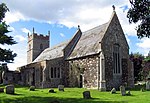Abbey and West Dereham railway station
1882 establishments in England1930 disestablishments in EnglandDisused railway stations in NorfolkEast of England railway station stubsFormer Great Eastern Railway stations ... and 3 more
Railway stations in Great Britain closed in 1930Railway stations in Great Britain opened in 1882Use British English from January 2018

Abbey and West Dereham railway station was a railway station on the line between Downham Market and Stoke Ferry. It served the village of West Dereham and the nearby St Mary's Abbey, in Norfolk, England. It was located south of the village on what is still called Station Road:
Excerpt from the Wikipedia article Abbey and West Dereham railway station (License: CC BY-SA 3.0, Authors, Images).Abbey and West Dereham railway station
Smeeth Drove, King's Lynn and West Norfolk
Geographical coordinates (GPS) Address Nearby Places Show on map
Geographical coordinates (GPS)
| Latitude | Longitude |
|---|---|
| N 52.57035 ° | E 0.4435 ° |
Address
Abbey Junction
Smeeth Drove
PE33 9RR King's Lynn and West Norfolk
England, United Kingdom
Open on Google Maps









